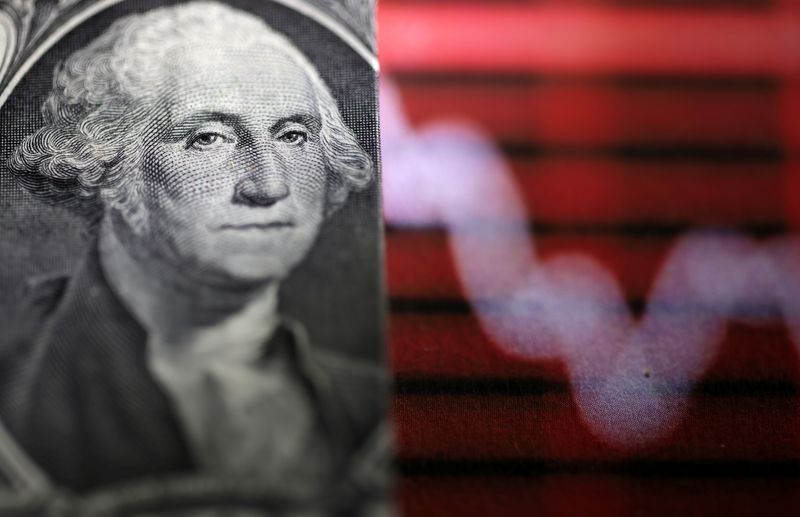By Alden Bentley, Naomi Rovnick and Ankur Banerjee
NEW YORK/LONDON/SINGAPORE (Reuters) -Global stocks, the dollar and some Treasury yields looked set to wrap up Christmas week on Friday with minor retracements of broad up-trends, succumbing to a dearth of interest and participation heading into the last weekend of the year.
Wall Street's main indexes opened lower, dampening an upbeat holiday-shortened week that started out looking like a classic "Santa Claus" rally was unfolding. The benchmark 10-year Treasury yield was up slightly but hovered below a near-eight-month high reached Thursday, while shorter-term Treasury yields eased.
The U.S. dollar was headed for an almost 7% annual gain while Japan's yen was set for a fourth consecutive year of losses on Friday, as traders anticipated robust U.S. growth, as well as tax cuts, tariffs and deregulation by the incoming administration of President-elect Donald Trump, would make the Federal Reserve cautious on rate-cutting well into 2025.
The Dow Jones Industrial Average was 0.56% lower after the open. The S&P 500 fell 0.65%, leaving Wall Street's benchmark on course for a 1% weekly gain. The Nasdaq Composite was down 0.79% in early trade.
The Dow is up 14% in 2024, the S&P 500 is up 25% and the tech-heavy Nasdaq is up 30%.
Analysts said stock markets could change direction as investors returned from holiday and reassessed the risks of elevated U.S. inflation under Trump for richly-valued Wall Street equities.
"There is some potential upside left for this bull market, but it is limited," said Pictet Asset Management chief strategist Luca Paolini.
"(Trump's) inauguration day is a potential inflection point and all the (prospective) good news will be in the price by then," Paolini added.
MSCI's broad global share index was 0.32% lower on Friday to remain 1.07% higher for the week.
MSCI's broadest index of Asia-Pacific shares outside Japan eased 0.12%, marking a 1.5% weekly rise, while Tokyo's Nikkei rose 1.8%.
Europe's Stoxx 600 was 0.27% firmer on Friday and 0.7% higher for the week.
The dollar index, which measures the currency against six other major currencies, eased 0.09%, looking at a small weekly gain, and to close 2024 with a more than six percent year-on-year gain.
Dollar/yen was down 0.15%, but near levels last seen in July, while the greenback was also showing a 5.3% gain this month against the yen and a near 12% advance for 2024 against the weakened Japanese currency. The euro , up 0.09%, stayed close to two-year lows.
The BoJ held back from a rate hike this month. Governor Kazuo Ueda said he preferred to wait for clarity on Trump's policies, underscoring rising angst among central banks worldwide of U.S. tariffs hitting global trade.
Fed Chair Jerome Powell said earlier this month that U.S. central bank officials "are going to be cautious about further cuts" after an as-expected quarter-point rate reduction.
The U.S. economy also faces the impact of Donald Trump, who has proposed deregulation, tax cuts, tariff hikes and tighter immigration policies that economists view as both pro-growth and inflationary.
Traders, meanwhile, anticipate the Bank of Japan will keep its monetary policy settings loose and the European Central Bank will deliver further rate cuts.
Traders are pricing in 37 bps of U.S. rate cuts in 2025, with no reduction fully priced into money markets until June, by which time the ECB is expected to have lowered its deposit rate by a full percentage point to 2% as the euro zone economy slows.
Higher U.S. rate expectations pulled the 10-year Treasury yield, which rises as the price of the fixed income security falls, to its highest since early May early on Thursday, at 4.641%. It was last up 1.4 basis points at 4.595%.
The two-year Treasury yield, which tracks interest rate forecasts, traded around 4.32% off 1.2 bp since late Thursday. U.S. debt trends also sent euro zone yields higher, with Germany's benchmark 10-year bund yield rising 4.8 bp to 2.372% on Friday.

Elsewhere in markets, gold prices dipped 0.84% to $2,612.20 per ounce, set for about a 27% rise for the year and the strongest yearly performance since 2011 as geopolitical and inflation concerns boosted the haven asset.
Oil prices were also set for a weekly rise as investors awaited news of economic stimulus efforts in China, the world's biggest crude importer. Brent crude futures rose 1% on the day to $73.99 a barrel, 1.5% higher for the week.
